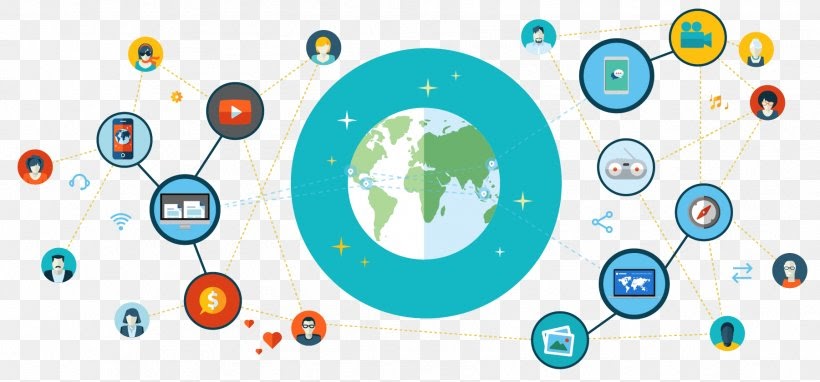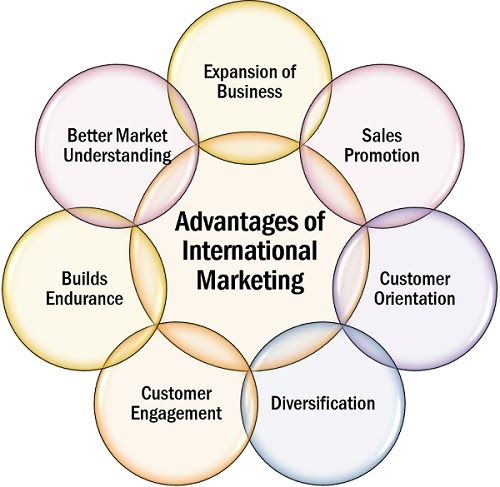What is International Marketing? Advantages, Factors, Examples
The economy is fierce competition, which means that international market expansion is the trend of most businesses. Currently, it can be said that Marketing is greatly influencing the operation of a company. For companies that have done well in the country, but want to attack international markets, international marketing is the solution that you are looking for. However, not everyone understands this term and uses them most appropriately with their business situation.
In today’s article, let’s find out What international marketing is and how to come up with an effective international marketing plan.
What is International Marketing?

International marketing is the conduct of business activities to control the flow of goods and services to consumers in more than one country for profit.
Or it can be understood as follows:
International marketing is the application of basic marketing principles to satisfy the diverse needs and desires of those who reside across national borders.
The only difference between international marketing and domestic marketing is that marketing activities take place in many countries. Whether domestically or internationally, the marketing goal is the same for marketers - making a profit by selling products or services where there is demand from consumers.
Enterprises participating in the international market such as Honda, Unilever, P&G all develop their own international marketing strategy activities. Dell is one of the typical brands in implementing global marketing by differentiating products by providing separate components for users to freely design their computers.
International marketing is divided into 3 main types:
-
Export Marketing: This is a marketing activity aimed at helping businesses bring their exported goods to the outside market. Thus, export marketing differs from domestic marketing because marketers have to study a new economy, including politics, law, and socio-cultural environment. Force businesses to change their domestic marketing programs to bring goods to foreign markets.
-
The Foreign Marketing: Marketing activities within the countries in which our Company has penetrated; This marketing is not like domestic marketing because we have to deal with a new type of competition, the behavior of the consumer is also different, the distribution system, advertising, and promotion are different and it is more complicated because Each country has different marketing environment, the important challenge here is that companies must understand different environments in each country to have appropriate policies, which is why senior marketing specialists become workers in one country but were very frustrated when asked to move to another country.
-
Multinational Marketing: Emphasize the coordination and interaction of Marketing activities in many different environments. Marketing staff must have careful planning and control to optimize the maximum synthesis and find the most appropriate marketing strategies applied in each country.
Explore more:
- What is Direct Response Marketing?
- What is an Internal Analysis?
- Attraction Marketing: Definition, Guide and Strategies
- 20 Best Marketing Books
Advantages of International Marketing

International marketing offers businesses some of the following advantages:
- Due to geographical factors and natural constraints, the item cannot be produced domestically, but thanks to international marketing the item is readily available.
- Give a superior way of life for the individuals by offering them a wide assortment of products and ventures.
- Build up the nation’s business, give many openings for work to individuals, and endeavor the accessible regular assets’ maximum capacity.
- Sensible assignment of assets and utilizing accessible assets at the universal level.
- The advantage in cost distinction. The advantages of division of work and work specialization at a universal level.
- Social and social trades between nations around the globe.
- Universal financial, political, social collaboration, and world harmony.
- To productively utilize the residential excess, present new item assortments, improve creation quality, and advance shared collaboration between nations.
- Extraordinary advantages during seasons of crisis, for example, starvation and floods.
- Wipeout shortages in exchange and installment parity of taking interest nations through fare advancement and import replacement.
- Simple forex is accessible to import materials of creation, present-day innovation, and other fundamental necessities.
- Fast extension of the tertiary segment incorporates transportation, protection, and delivery.
Please remember that the above preferences or advantages are possibly gotten when international is not sensibly confined and directed. Sadly, practically all nations have forced different limitations on the free development of merchandise. Such exchange limitations are unwanted because they limit the extent of free and reasonable universal promoting.
3 Main Factors to Consider in International Marketing

International marketing is incredibly different from domestic marketing. There are a full host of issues when marketing internationally that a business doesn’t normally must cope with when marketing in their own country. The subsequent are some key things to contemplate when making any international marketing decision.
1. Economy
Researching the economy of the market that the enterprise intends to attack is indispensable in the process of entering international markets. This process includes information gathering, comparison, and analysis, overall and detailed assessments of critical aspects of the economy such as people’s income, social structure, and market demand. , financial transactions, etc.
From there, capture the situation and the fluctuation trend in the business’s field and related products. From there as the foundation and basis for building marketing strategies.
2. Culture
As noted above, culture and demographics in the host country will greatly influence international marketing results. Specifically:
- Culture influences the nature of marketing strategies, specific strategies, and measures.
- Culture influences the choice of the business sector and target market
- Culture influences product tooling, distribution, and promotion mixes.
To be successful in international marketing management, you need to know and comply with the host country’s culture and laws. Besides, administrators need to study in-depth on consumer behavior and habits here. It is possible to change the packaging, the price as well as come up with the right service strategy to be successful
For example, when the McDonals entered the Indian market, they did in-depth research before setting the Indian diners’ menu. The entire menu has been reworked to suit Indian tastes. 40% of the menu items are vegetarian food. Also, McDonald’s includes various items that even remove beef and pork dishes from the menu to respect Indian culture.
This is an example of product localization. This has created success for the Indian market products and helped the brand become familiar to the local population.
3. Politic
International marketers need to consider host country political influences on companies in foreign markets. One thing that needs special attention is the political stability of the country. Political instability and rapid change create a risky environment for doing business. It is also interesting to note that its national origin often identifies an international company. This can be good or bad, depending on domestic and foreign government relations.
Indeed, consumer goods are more politically sensitive than industrial goods, and finished products are more sensitive than the materials and ingredients that make up the product.
A negative political environment will create different effects on the company in foreign markets. It may limit the marketing program or the sale of the product in that market. It can also make it difficult to get a license or return profits to the parent company, and it can also create a boycott of a product. International marketers need to study the political environment as an essential part of marketing planning.
Read more:
- What is Market Orientation? Pros, Cons
- What is Green Marketing?
- What is Marketing Audit?
- What is Ambush Marketing?
How to Develop an International Marketing Plan
After you have grasped what international marketing is, you will probably ask yourself how to plan a perfect International marketing plan. You will probably want to check out the following steps:
1. Analyze the international marketing environment
From the concept, the nature of international marketing mentioned above, we know that for businesses, analyzing the international marketing environment is the first and very important job because the marketing environment has a direct influence next to the production and business activities of each enterprise.
Therefore, it is necessary to study the habits, usage habits, and tastes of foreign consumers for the type of product that the company wants to penetrate. Not only that, marketing research here in addition to studying all factors like domestic marketing research, but also studying political factors, legal, international economy, international finance, and national culture, health. As such, the marketing planners must always analyze the marketing environment relevant to the business activities, including internal and external environments. Doing this job well is to create a premise or a fulcrum to develop the next steps.
2. Evaluate the ability of enterprises to penetrate foreign markets
After thoroughly analyzing the international marketing environment, the next step to do in the international marketing model is to assess a firm’s ability to penetrate foreign markets, or in other words, to conduct the analysis, accumulate strengths, weaknesses, opportunities, and threats (SWOT analysis). These include considering the benefits of market entry, assessing the company’s risks, and competitiveness in that market to highlight the company’s competitive advantage over competitors. Find out the business possibilities and prospects as well as the profits earned from that market. Based on the data, assumptions, and information gathered from the first step, the assessment often focuses on:
- Applied technology of the business
- Designs, models and brands of products
- Product quality, quality control, and product life cycle
- The perfection of the industry
- Customer service
- Ability to supply raw materials
- Price, cost and distribution structure
Strengths are derived from internal, subjective factors that can be expressed in corporate reputation, customer loyalty, corporate culture, business position, finance, effective export support forms, and methods.
Moreover, stemming from internal factors and weaknesses that an enterprise may encounter is the industry’s weakness, the product is too different; the customers are not used to it, the planning work. It is not good due to the international business team’s weakness, the high cost of allocation, and the cost.
Opportunities come from external factors and are objective. These are favorable external environmental factors, the rapid development of major market segments, competitors are not strong enough, business opportunities arrive at the right time requiring businesses to quickly grasp and seize the opportunity and then take advantage and promote to gain an edge over competitors.
However, if you do not recognize an opportunity, it will most likely turn into a challenge for businesses when that opportunity falls into other businesses’ hands. Threats can be the underdevelopment of the international economy, legal barriers, political conflicts, adverse changes in customer tastes, etc
3. Develop an international marketing strategy

Step 1: Target market selection
After researching and analyzing global marketing carefully, the next step to take in the international marketing model is to select your target market. Based on the above-researched factors, at this time, the company will conduct classification, refinement, and selection of the target market. How the target market is chosen depends on the goods that the company will penetrate foreign markets. The choice of the target market here relates to a number of issues that the company must consider such as the needs of that market, the size of the market, the development of the market, the competitive situation in the market, risk factors, etc
Through all these factors, companies make a selection of the potential markets that the company feels most dominant and most likely to succeed.
Step 2: Decide on the form of market entry
It is a vital job and an indispensable part of the international marketing model because it shows the type of penetration the most influential companies can use. You can choose one of the following options:
- Export
- Business association
- Direct investment
Step 3: Set up an international marketing plan and goals
This means giving marketing objectives and setting up international marketing programs such as market research content, product positioning, and establishment of marketing factors - mix.
Defining international marketing goals: Based on steps 1 and 2, the company will set long, medium, and short-term goals for each category, each product, and each different market. Depending on each time, there is a flexible adjustment of these goals; it is unnecessary to implement too rigidly because sometimes opportunities in foreign markets do not always go hand in hand with the already established goals. Fabricate.
International marketing planning: Like Marketing - domestic mix, Marketing - mix in global marketing also has 4 factors in defining: product, price, distribution and sale promotion in which all elements These are all serving and supporting other activities in international marketing or in other words, these four factors have been established equally to be associated with foreign markets.
Organize the implementation, test, and evaluate the performance of the international marketing plan. This is the last step and also a crucial step in the model of international marketing activities. Implementation organization: is the process of answering the questions “Who?”, “Where?”, “When?” and “How?”.
Typically, companies conduct international marketing in at least three ways: setting up an export sales department, an international branch, and becoming a global organization.
The Export Sales Department is responsible for organizing and exporting the company’s products to foreign countries. After that, the export department can expand its export marketing services.
The international branch handles the company’s overseas operations. Staff in these branches are experts in marketing, research production, finance, planning, and human resources.
Global organization: companies that go out of the country to actually become transnational companies. At this time, transnational companies create international marketing plans, production facilities worldwide, and a wide variety of financial resources and distribution systems. They set up organizations that operate globally, reporting directly to the general manager or company CEO. The company can hire managers from many countries, buy the cheapest source of materials and components, and invest in the most profitable place.
Step 4: Test and evaluation
The following three types can be applied to test the implementation of the international marketing plan well:
- Check out the annual plan
- Test profitability
- Quality control
The test content can be the implementation of product plans, profitability, the effectiveness of marketing - mix activities in the first year, and the basis for planning international marketing in the coming years. A test basis can be based on sales results, market share analysis on markets, cost analysis, financial analysis, and customer response.
These are all steps that need to be carried out in the international marketing model. Any business company operating in a competitive environment needs to identify one factor that plays a vital role in its success or failure: its marketing strategy and its execution. The more detailed the international marketing model building, the more likely a company is to do business successfully and compete successfully in the marketplace.
Related posts:
- Marketing Intermediaries
- Why Reorder Point Can Hurt Your Business?
- Reach vs Impressions: Key Differences
- Best Elements & Types of Marketing Collateral
Conclusion
Creating a strong market in the international marketing environment is a challenging job. Therefore, a good marketing manager will have to consider and know to focus on what they can control instead of reaching out.
Therefore, Marketers must accept difficult conditions and create an advantage for their business on the global market. It is both a challenge and an opportunity for marketers who want to experience themselves in a new environment.
Hopefully, with the above knowledge about International marketing and how to plan international marketing, you can find the right way to bring success to your business.
Recommend:
New Posts






